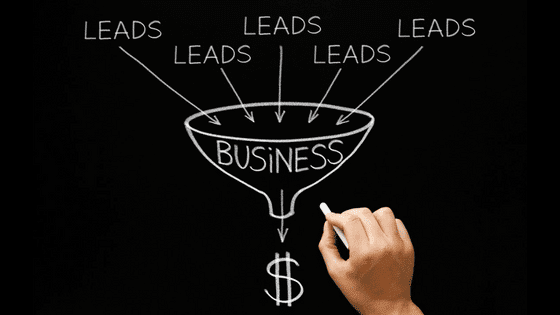In marketing, a little planning trick called a sales funnel can help you understand your ideal customer and their journey. On paper, it just looks like some scribbled notes with a cryptic meaning. In practice, this could be the best tool to plan and implement a full digital marketing campaign strategy.
Simply put, a sales funnel is the process in which consumers buy products; it is made up of multiple steps to help guide the buyer toward a buying decision. It is what enables you to make potential customers into buying customers.
These steps can vary, but when it comes to creating digital marketing campaigns, these steps can be improved or accentuated to increase the effectiveness of the selling.
The steps in a sales funnel are:
- Awareness
- Interest
- Evaluation
- Decision
- Action
- Recurring action
Here they are in more detail.
1. Awareness
This is where the buyer becomes aware of the product or a solution to their situation and needs. The customer will be visiting your site for the first time. This is where marketing efforts play a huge role because customers will be interacting with your advertisement or a blog in the awareness step.
While it is possible to use any type of marketing for any purpose, the assets that work best to spread awareness are advertisements. With awareness, you are trying to make as many people aware of your brand as possible. Advertisements are a way you can find potential customers who would have otherwise never landed on your website.
The content you should make for this level of the funnel is generic. What you are selling or offering and some of the benefits those products can offer.
2. Interest
Not everyone will purchase your product or hire your services, so as your digital marketing strategy progresses, you will lose people who would not make good customers. Perhaps they misunderstood your offer or realized they didn’t need it at that time. Regardless, you should continue to nurture those who are still interested.
In the interest phase, potential customers show curiosity by researching the product and actively looking into the features to see if the product will actually help them. This means expressing interest in your product by browsing your website. The customer may even follow you on social media or subscribe to your blog or newsletter.
This step is where content marketing can play a big role in converting a lead into a customer. People in the interest phase realize that the product or service they have stumbled on can improve their life in some way and want to learn more about it.
In this phase, customers are hungry for content. They will be looking for answers to questions like:
- What are the features that make this product or service different?
- How can these features be used to achieve the promised benefits?
- Is this the right thing for me to achieve my goals and desires?
Your primary goal in this phase is to anticipate and resolve questions, so the customer has all the information they need to make a conclusive decision on whether to proceed with the purchase.
3. Evaluation
Many buyers will take their interest a step further by evaluating the effectiveness of your solution or product by comparing it with competitors’ solutions and products.
If you have yet to adequately express how your product is better suited to bring the desired results than your competitors, then this step is where you will lose most of your leads.
Once your customers think they know enough about your product, they will look for a better deal to achieve the same results. This deliberation is why you need strong content featuring your products and services.
In this phase, it also helps to have good reviews. Suppose a customer is trying to make a decision. In that case, seeing what other people thought and did when they were in a similar dilemma can help them feel confident about purchasing your product or hiring your services.
4. Decision
It’s decision time, which means the buyer decides to become your customer. This is when the customer will spend time deciding which package or shipping option to choose and will pay close attention to exactly what you offer.
Some important things for your customer to understand will be whether you have a money-back guarantee, how the item will arrive at their home, and if tracking options are available.
Of these things, being clear about your return policy is critical. The return policy is the parachute after the plunge. When someone buys something, especially if it is pricy, they want to know they can fix their problem if they don’t end up liking the purchase.
If you are worried about how a return policy will affect your sales and profits, remember that return rates differ by industry and make up a small percentage of products purchased. It could be worth the risk of removing potential sales barriers for your customers, especially if this is something your competitors offer.
5. Action
The action step is the actual sale. The customer has gone through the buying process and presses the “place order” button. Money is exchanged in the action step.
In this phase, the customer will be either fighting or justifying their decision. There is still a possibility your customer will forgo the purchase and abandon their cart. This might be caused by anxiety over the price, a worry that they can score a better deal elsewhere, or a lack of funds.
Understanding why a person would abandon their cart is important for email campaigns reminding them about their pending purchase.
Another essential thing to do is ensure your purchasing flow is as seamless as possible. The more pages a customer has to click through, the likelier it is that they will abandon their cart.
6. Recurring Action
Loyal customers are the best investment for your business. Keeping happy customers will make it easier for you to get more sales because you already have satisfied customers who have gone through the sales process.
Now that you have happy customers, you can upsell them or otherwise encourage them to buy from you again. These marketing campaigns are often much less expensive because you’ve already earned their trust and have their contact information.
Revity Marketing Sales Funnel Expertise
Are you trying to market a product or service using a sales funnel? Creating a digital marketing campaign is easier than you might imagine it to be. But if you want to free up a lot of time and energy spent learning how to run and operate an effective marketing campaign with a sales funnel, consider having us help you!
We love helping businesses find success in the online world. Contact us today to see how we can help you get returns on your online sales.







